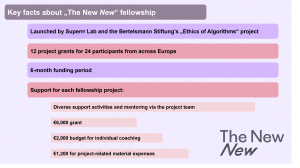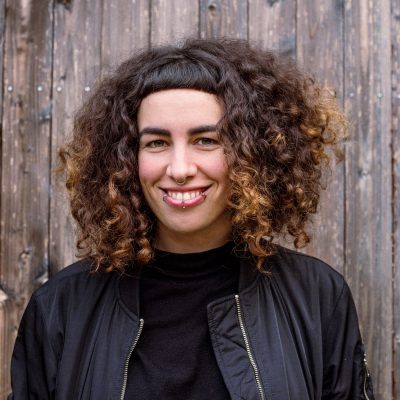Introduced in 2021, “The New New” fellowship provides a framework for working towards inclusive visions of our digital futures. For organizations engaged in similar undertakings, we now present five overarching insights of the program.
Debates about the metaverse currently attracting media attention underscore the extent to which economic actors are once again playing an outsized role in determining the shape and narrative of our futures. These debates often overlook the fact that digital-savvy representatives of civil society have long lacked the support they need to develop alternative future visions, and to implement their projects and ideas. We need to increase this support and thus facilitate the social value it creates. That is why we hope to make a contribution to this goal through The New New, which was created as a space to explore how inclusive visions of our digital futures can be tested while paying attention to the role of technology in the process. As part of this, a first fellowship program offered activists the opportunity to develop further their own projects while contributing to debates about important aspects that shape our futures:
- What kind of world do we want to live in? What role do new technologies play in shaping this future?
- How can we change existing power relationships and policy priorities in order to allow for a stronger focus on social justice and sustainability in digital transformation?
- What are the alternatives to dystopian and utopian narratives in the context of digital transformation? Which groups in society are being left behind in terms of creating just and inclusive digital futures?
In a blog post marking the end of the first “The New New” fellowship, we summarized main activities that took place during this first round of fellowship support. We now present our overarching findings for the benefit of those organizations and individuals looking to implement similar projects. We are happy to provide, upon request, further details about the insights we’ve gained.

Our fellowship program findings:
1. A strong selection process is critical to the quality of a fellowship program
The selection of fellows is the most important factor in determining the program’s success. The more committed the selected fellows are, and the more clearly program expectations are communicated at the outset, the easier it is to support individual fellows and their projects.
- The design and language of the call for applications were kept simple and easy to understand. The importance of an inclusive, supportive environment that is facilitative of diversity was clearly communicated from the beginning.
- The call for proposals clearly stated the benefits (i.e., funding modalities and support services) as well as expectations regarding fellows’ workloads.
- The application form was comprised of a clearly formulated set of questions, which helped ease the burden involved for applicants and thus increased fellowship accessibility.
- The call for applications was not limited to new projects; initiatives already underway were also eligible for consideration. Opening up the fellowship to such projects not only mitigates barriers to submitting an application, it also contributes to the long-term viability of approved projects.
- Projects were selected by an advisory board comprised of individuals representing a variety of disciplines and subject areas. Representing a diverse set of perspectives and posing critical questions, the advisory board helped ensure a more inclusive selection process.
2. Maintain flexibility and respond to individual needs
In addition to providing financial help, suitable assistance for a diverse group of people and projects involves offering services that provide dedicated support in addressing individual needs. Identifying these needs requires a willingness to be flexible:
- The program was designed with the goal of being able to respond flexibly to each fellow’s specific needs and requirements. Ultimately, however, the fellows’ desire for dialogue and networking was stronger than anticipated. We addressed this through various workshops and formats designed for dialogue.
- Building a relationship of trust between the project team and fellows is a very rewarding process. It therefore makes sense to signal a low threshold with regard to availability and receptiveness in responding to each fellow’s areas of interest. This can be demonstrated in several ways, including introductory one-on-one telephone calls with each fellow.
- Maintaining clear procedures and a lean bureaucracy can help ensure secure processes in operational matters. Standard operating procedures should therefore be communicated early on and in ways that are understandable to everyone. Providing guidelines for procedural issues is one way to do this.
- Coaching/Mentoring was one means of addressing individual needs that fellows valued in particular. Having fellows identify specific coaching opportunities themselves that the project team could then commission proved to be especially helpful.
3. Recognize and promote community-building efforts among fellows
Efforts to build a community among the fellows provide additional value, as the fellows, in their capacity as experts, can learn a lot from each other. They can build ties where their interests overlap and thereby broaden their understanding of their own target groups.
- Getting to know each other and exchanging ideas about individual areas of focus through common spaces and events provided or organized by the project team are crucial to building trust and networks among the fellows. Facilitating a culture of exchange in this way allows the fellows to benefit from the broad range of expertise within the program.
- Joint meetings should include time allocated for discussing shared values, the details of project plans, and what fellows expect from the program.
- In addition to providing shared opportunities for dialogue, it is worthwhile to ask the fellows early on about their desired channels for asynchronous communication (newsletters, Slack, etc.) and to make these available to everyone involved in the fellowship program.
4. As a building block for existing activism, the fellowship should include activities that serve this end
Many of the approved applications for “The New New” fellowship were for projects already in existence. As such, the program provided them support with professionalization. These projects continue to exist beyond the fellowship. Funding should therefore seek to help ensure that projects outlast the fellowship period.
- Any joint exchange of ideas should, ideally, discuss and highlight the viability of individual projects beyond the fellowship. At the end of “The New New” fellowship, participants were able to state their project goals for the months following the fellowship.
- Fellowships should provide participants the opportunity, through channels such as interview and workshops, to report internally and publicly on the contents of their projects and their plans. This can help to build self-confidence and motivation among the fellows.
- The financial support provided by the fellowship gives the fellows the opportunity to think strategically about their projects and opens doors to further project development. This potential should be developed together with the fellows during the funding period and always be taken into consideration. Networking with relevant contacts and identifying potential follow-up activities exposes participants to consideration-worthy support opportunities.
5. It’s important that the project team reflect on its own role in the fellowship and act in the best interests of the fellows
By definition, the funding role entails an unequal power relationship with the fellows. It is therefore very important that project team members continually reflect on this relationship and seek to adress this imbalance as much as possible. The intended goal here is to allow fellows the freedom they need to work on ideas for their projects:
- With the vast majority of fellowships, the fellows are the primary target group of the activities organized by the funding organizations. It is therefore important to express confidence in the fellows’ plans and allow them the free rein they need. This is not always what happens. Many projects often undergo major adjustments in order to meet the requirements and wishes of funding organizations. The framework and focus of the first “The New New” fellowship were therefore clearly communicated with transparency in advance, thereby leaving it up to participants to specify their project design during the fellowship. This approach allows to offer fellows suitable support.
- Further support provided by the Allianz Kulturstiftung and the Goethe Institute during the course of the project was oriented at the fellowship’s predefined subject area. This made it easier for the organizations involved to coordinate their activities within the established parameters. At the same time, the fellows benefited from the additional input provided by these partners.
- In order to provide fellows suitable support, it’s important to schedule sufficient timelines. The fact of the matter is that some of the fellows’ needs and wishes aren’t made clear until the first joint meetings. In order to be able to respond effectively to such things on short notice, those responsible for running the fellowship should take into account buffer times in schedules.
This text is licensed under a Creative Commons Attribution 4.0 International LicenseKloi




Write a comment